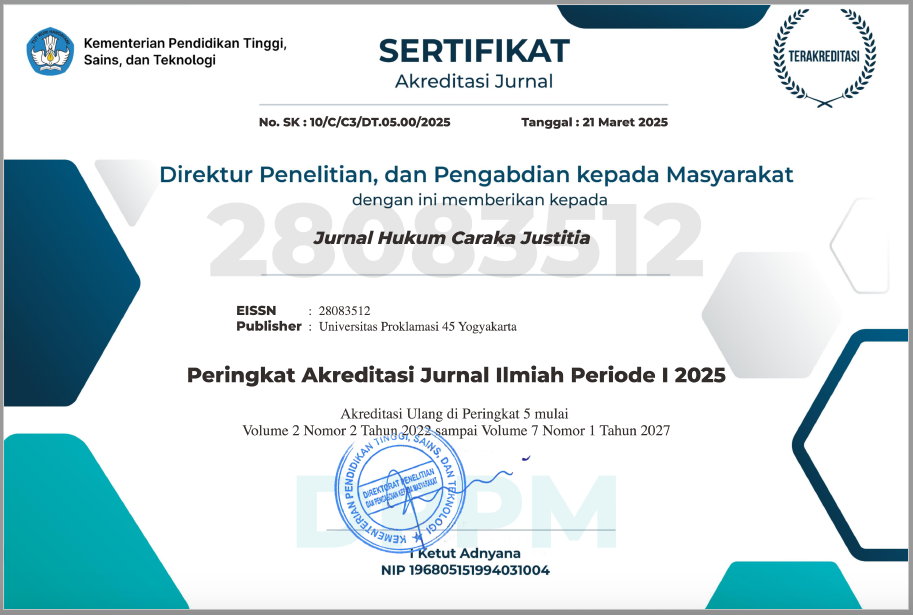Perlindungan Hukum Bagi Nasabah dan Bank Terhadap Tindak Kejahatan Berbasis Teknologi Informasi (Cyber Crime)
DOI:
https://doi.org/10.30588/jhcj.v2i1.1035Keywords:
Legal Protection, Customers and Banks.Abstract
Banks as intermediary institutions and trust institutions as the driving force of a country's economy, in their activities, cannot be separated from the use of information technology to support their operations. The use of information technology by banks in addition to having a positive impact also has a negative impact that will threaten and harm the bank and its customers, if not managed properly. Banking crimes that use information technology, especially against bank products and services that use computers and internet networks (Cybercrime) will cause losses to customers and the bank itself.
This research is normative juridical research that is descriptive-analytical with a case approach to identify and analyze forms of crime in the banking world and the efforts made by the government CQ. financial authorities in providing legal protection for customers and banks from criminals who use information technology.
The results of this study indicate that cybercrime is a crime using information technology that can be carried out without recognizing territorial boundaries and no direct interaction between perpetrators and victims of crime is required; so that the government, as well as the monetary authority (BI) and the Financial Services Authority (OJK) as supervisors in the financial and banking sectors, need to protect the public (customers) and banking institutions, namely by taking preventive and repressive actions by implementing existing laws and regulations and coordinating with law enforcement officers in preventing the occurrence of Cybercrime and providing severe penalties for the perpetrators of these crimes.
References
Artikel Jurnal
Carroll, Michael W. “Computer-Related Crimes American”. Criminal Law Review 32, (2000): 183-210. https://digitalcommons.wcl.american.edu/cgi/viewcontent.cgi?article=2535& context=facsch_lawrev.
Sari, Nani Widya. “Kejahatan Cyber Dalam Perkembangan Teknologi Informasi Berbasis Komputer”. Jurnal Surya Kencana Dua: Dinamika Masalah Hukum dan Keadilan 5, no. 2 (Desember 2018): 577-593. http://download.garuda.kemdikbud.go.id/article.php? article=1696085&val=18449&title=kebijakan%20kriminal%20pemerintah%20terhadap%20kejahatan%20dunia%20maya%20cyber%20crime%20di%20indonesia/1000.
Veresha, Roman V. “Preventive Measures Against Computer Related Crimes: Approaching An Individual”. Informatologia 51, no. 3-4 (March 2018): 189-199. https://doi.org/ 10.32914/i.51.3-4.7.
Buku
Hadjon, Philipus M. Perlindungan hukum bagi rakyat Indonesia. Surabaya: PT. Bina Ilmu, 1987.
Hamzah, Andi. Hukum Pidana yang Berkaitan Dengan Komputer. Jakarta: Sinar Grafika, 1993.
Peachey, Alan N. Bencana Keuangan Besar Masa Kini (Great Financial Disaster of Our Time). Jakarta: Indonesian Risk Profesional Association (IRPA), 2007.
Artikel Online
Hukumonline.com. “Aturan tentang Cyber Pornography di Indonesia”. https://www.hukumonline.com/klinik/a/aturan-tentang-icyber-pornography-i-diindonesia-lt4b86b6c16c7e4 (diakses 12 Desember 2021).
Peraturan Perundangan-Undangan
Undang-Undang Nomor 11 Tahun 2008 tentang Informasi Dan Transaksi Elektronik.
Undang-Undang Nomor 10 Tahun 1998 tentang Perubahan Undang-Undang Nomor 7 Tahun 1992 Tentang Perbankan.
Undang-Undang Nomor 8 Tahun 1999 tentang Perlindungan Konsumen.
Peraturan Bank Indonesia Nomor 9/15/PBI/2007 tentang Penerapan Manajemen Risiko Dalam Penggunaan Teknologi Informasi Oleh Bank Umum.
Downloads
Published
How to Cite
Issue
Section
License
Copyright (c) 2022 Benedictus Renny See

This work is licensed under a Creative Commons Attribution 4.0 International License.
Authors who publish with JHCJ agree to the following terms:
Authors retain copyright and grant the JHCJ right of first publication with the work simultaneously licensed under a Creative Commons Attribution 4.0 International License that allows others to share (copy and redistribute the material in any medium or format) and adapt (remix, transform, and build upon the material) the work for any purpose, even commercially with an acknowledgment of the work's authorship and initial publication in JHCJ.
Authors are able to enter into separate, additional contractual arrangements for the non-exclusive distribution of the journal's published version of the work (e.g., post it to an institutional repository or publish it in a book), with an acknowledgment of its initial publication in JHCJ. Authors are permitted and encouraged to post their work online (e.g., in institutional repositories or on their website) prior to and during the submission process, as it can lead to productive exchanges, as well as earlier and greater citation of published work (See The Effect of Open Access).














